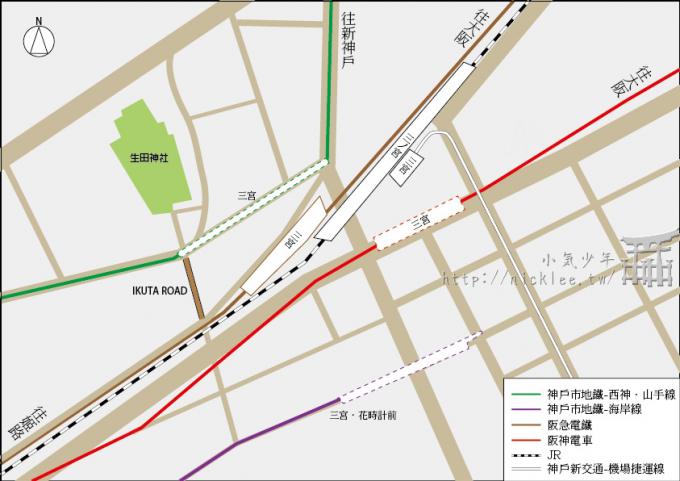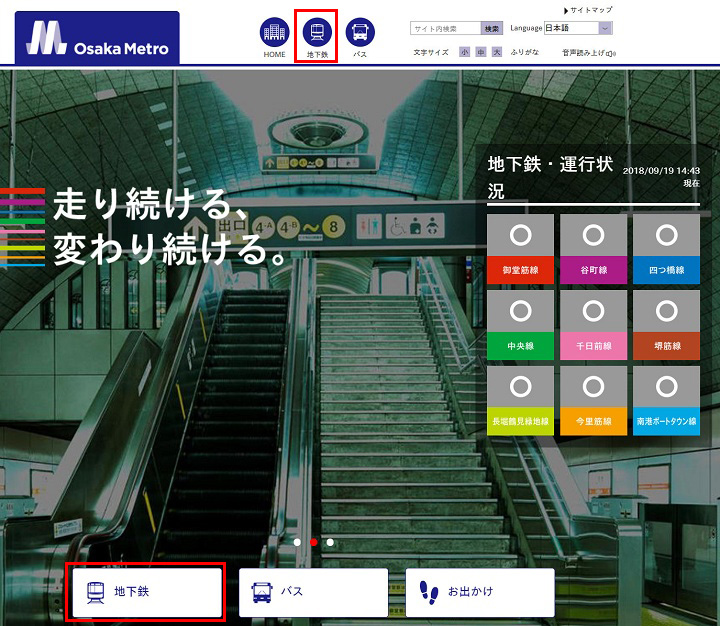The Sannomiya area in Kobe is just as complex as Osaka’s Umeda and Namba. However, the cost of living in Kobe seems to be relatively cheaper. There are plenty of delicious food options and many beautiful scenic spots. Additionally, the Sannomiya area serves as an important hub. Therefore, this article is one of the basic transportation articles that people who are planning to travel to Kobe should read.
Category: Travel
Understanding the Osaka Subway Timetable
Osaka Metro is the most important transportation tool in Osaka for visiting major attractions. The utilization rate of Osaka Metro is estimated to be over 90%. Although the train frequency is high, if you are only traveling within the Osaka Metro, there is no need to check the schedule. However, if you are taking the Sakaisuji Line or the Chuo Line, which are connected to other railway lines, it is important to carefully check the timetable to avoid taking the wrong train and wasting time.
[Taipei] Yangmingshan Pingjing Street, Lane 42, Cherry Blossoms | Pink and Tender Cherry Blossom Viewing Spot
The cherry blossoms in Pingjing Street, Taipei’s Yangmingshan Pingdeng Village, have bloomed earlier this year, attracting a large number of visitors. The cherry blossoms are currently at 80% bloom and are expected to reach their peak this week. Many people have been taking photos of the cherry blossoms using wide-angle lenses to capture their beauty.
[Japan] Tokyo Free and Easy – Ameyoko Street, World Trade Center Night View, Tokyo Tower
The author and their friends planned a trip to Tokyo for five days and four nights, but due to a typhoon, the trip was extended to six days and five nights. The itinerary included visiting various attractions such as Ameyokocho, Tokyo Tower, Asakusa Temple, Akihabara, and more. The author also mentioned their photography equipment and the flight they took to Tokyo. They visited the Seaside Top Observatory at the World Trade Center Building and the Tokyo Tower Observatory. The first day ended with a visit to a public bathhouse.
[Japan] Tokyo Skytree Shooting Route Map | Taking Photos by Bicycle
The Tokyo Skytree is the tallest building in Japan and a landmark in Tokyo. It can be seen from almost any corner of the city. This article describes a bike tour of nine photography spots in Asakusa to capture the beauty of the Tokyo Skytree. The author rented a bike easily in Asakusa and visited various locations to take photos. The article provides a map and descriptions of each photography spot.
[South Korea] Experience the Charm of Hanok in Seoul’s Anguk Bukchon Eight Scenic Spots | Map and Photo Guide
The author visited Bukchon Hanok Village in Seoul, South Korea as part of a work trip. They recommend visiting the village and provide information on how to get there. The author describes the different attractions within the village, including the Bukchon Cultural Center and various scenic spots. They mention that the village is known for its traditional Korean houses and recommend wearing comfortable shoes due to the hilly terrain. The author also mentions that the village has been featured in Korean dramas. They briefly mention the Dunmei Pharmacy and the viewpoint at Bukchon Four Scenic Spots. The author notes that the village was not crowded during their visit and suggests spending more time exploring the area in the future.
[South Korea] Changdeokgung Palace Secret Garden Reservation | Must-Visit Attractions in South Korea
Changdeokgung Palace is a separate palace built in 1405 after the completion of Gyeongbokgung Palace. It is one of the five major palaces in Seoul, South Korea. The palace’s rear garden, known as the Secret Garden or Forbidden Garden, requires a reservation to enter. Visitors can make reservations online through the palace’s official website. The Secret Garden tour lasts for 90 minutes and includes various attractions such as the Lotus Pond and Changdeokgung Palace. It is recommended to wear comfortable shoes and sunscreen when visiting. The palace is open from 9:00 am to 6:00 pm during the months of February to May and September to October, and from 9:00 am to 6:30 pm during the months of June to August.
[Taipei] Taipei Awanda Leisure Manor Maple Leaf Viewing | Spring Maple Leaf Viewing in the Suburbs of Taipei
Taipei residents can easily enjoy maple leaves in the suburbs. Taipei Awanda Leisure Estate, located in Yangmingshan, turns red from March to April, providing a unique atmosphere for visitors. The estate offers various activities and dining options, allowing visitors to experience the feeling of autumn maple leaf viewing. The estate also offers desserts and beverages, with options for those who prefer less sweetness. The maple leaf viewing season lasts until late May, and visitors can enjoy a leisurely afternoon with family or friends. The estate is open daily, and ticket prices can be used towards food and beverage purchases.
[Taipei] Binjiang Street Airplane Lane for Watching Airplanes | Binjiang Street 180 Lane, Binjiang Market for Close-up Plane Viewing
The “Airplane Alley” in Taipei is a popular spot for watching planes land and take off from Songshan Airport. Due to its popularity, there have been rumors of the alley closing in 2019, leading to increased crowds of visitors. In addition to the alley, the rooftop of the nearby Binjiang Market also offers a close-up view of planes. However, visitors are reminded to prioritize their safety and not engage in any behavior that may pose a risk to the planes or themselves. The article also provides tips for photographing planes, including using high-speed continuous shooting and selecting appropriate lenses.
[Hong Kong] A Day Trip to Stanley | Must-Visit Attractions for Free and Easy Travel in Hong Kong
Stanley, located on the southern coast of Hong Kong Island, is a popular tourist destination and a must-visit spot for those traveling to Hong Kong. It offers various attractions such as Stanley Street, Stanley Market, Stanley Plaza, and Murray House. The town got its name from the red cotton trees that used to grow there, resembling red pillars when illuminated by the sunrise. Stanley is easily accessible by bus from Central, Causeway Bay, and Tsim Sha Tsui. Visitors can enjoy a leisurely day exploring the different areas of Stanley, including the vibrant Stanley Street and the historic Murray House. The Stanley Plaza shopping mall offers a range of shops and dining options, while the iconic Murray House provides a glimpse into Hong Kong’s history. The Stanley Market is a bustling area with various shops selling clothing and Chinese handicrafts. Overall, a half-day trip to Stanley offers a unique and relaxed experience in Hong Kong.




![[Taipei] Yangmingshan Pingjing Street, Lane 42, Cherry Blossoms | Pink and Tender Cherry Blossom Viewing Spot](https://mail.vibedaily.io/wp-content/uploads/2023/10/b091041c3f32bdde48fecd137de17291_1.jpg)
![[Japan] Tokyo Free and Easy – Ameyoko Street, World Trade Center Night View, Tokyo Tower](https://mail.vibedaily.io/wp-content/uploads/2023/10/3f11827546b68a35bac9c25542d02741_1.jpg)
![[Japan] Tokyo Skytree Shooting Route Map | Taking Photos by Bicycle](https://mail.vibedaily.io/wp-content/uploads/2023/10/3a3b214babfa1ac850c9d8539a2a16cb_1.jpg)
![[South Korea] Experience the Charm of Hanok in Seoul’s Anguk Bukchon Eight Scenic Spots | Map and Photo Guide](https://mail.vibedaily.io/wp-content/uploads/2023/10/65c998bfa7882fbb346467751a652b06_1.jpg)
![[South Korea] Changdeokgung Palace Secret Garden Reservation | Must-Visit Attractions in South Korea](https://mail.vibedaily.io/wp-content/uploads/2023/10/9da90d7bb0dac0fb5dfb32441caaa202_1.jpg)
![[Taipei] Taipei Awanda Leisure Manor Maple Leaf Viewing | Spring Maple Leaf Viewing in the Suburbs of Taipei](https://mail.vibedaily.io/wp-content/uploads/2023/10/8f30aa7d7d229f964e3aef232eed5255_1.jpg)
![[Taipei] Binjiang Street Airplane Lane for Watching Airplanes | Binjiang Street 180 Lane, Binjiang Market for Close-up Plane Viewing](https://mail.vibedaily.io/wp-content/uploads/2023/10/eaa5f2fee5bbef63fbe23e1bbddbf31a_1.jpg)
![[Hong Kong] A Day Trip to Stanley | Must-Visit Attractions for Free and Easy Travel in Hong Kong](https://mail.vibedaily.io/wp-content/uploads/2023/10/86ec072227464775b48c7f5ad96525d4_1.jpg)